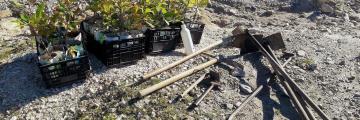Environment

Our carbon footprint is not automatically excused just because art is our activity. And, since 2009, we decided to burden the production costs of the artistic project with a carbon tax that compensates the planet for the greenhouse gases that it implies. Greenhouse gases are gaseous substances that absorb part of the infrared radiation, mainly emitted by the Earth's surface, and hinder its emission into space, keeping the Earth warm. The greenhouse effect is a natural phenomenon. This phenomenon happens since the formation of the Earth and is necessary for the maintenance of life on the planet. However, the increase in greenhouse gases in the atmosphere has surpassed this natural phenomenon, causing an abnormal increase in temperature and consequently a climate change that, according to experts, could be potentially catastrophic.
By introducing a carbon tax in its annual expenditure budget, Visões Úteis hopes to contribute, in a positive and active way, not only to raising awareness on the problem of emissions and greenhouse gases, but also, in a direct way, to support entities that are dedicated to environmental preservation and energy sustainability.
This is a cost for which we insist on takin responsibility, and which applies not only to any type of travel likely to produce greenhouse gases, namely cars and planes, but also to the current consumption of energy in our facilities. Thus, we proceed to the annual calculation of the emission of gases associated with the development of our activity and we consider this ecological footprint as a cost that our production necessarily assumes, committing ourselves to contribute, in equal measure, to projects whose activity allows to reduce global emissions of carbon. The goal is a balance between our emissions and our contributions, so that, through this informal acquisition of carbon credits, Visões Úteis' activity is as ecological as possible. And to account for our Carbon Tax we use international reference standards, in particular the Green Initiative calculator.
In 2019, the last year accounted for, the Visões Úteis activity resulted in the emission of 7.5 tons of Greenhouse Gases (2000 kg referring to fuel consumption, 3000 kg referring to air travel and 1500 kg referring to electricity consumption ). Offsetting these emissions required – as a reference value – the planting of 48 trees.
The planting of these trees is done in the Serra de Valongo, near the city of Porto, where we are based, and in collaboration with Movimento Terra Solta. Terra Solta is an association of solidarity economy initiatives that promote environmental, social and economic sustainability and that has already been our partner in several projects. It is headquartered at Quinta Pedagógica de Campanhã, located on the grounds of the Youth Center of Campanhã (next to the station).
In practical terms, how is it done? Throughout the year, Terra Solta sows the trees in small pots, and later indicates us the place and day to plant the number of trees needed to absorb (per year) an amount of carbon identical to that released by us in the previous year. On the appointed day, Visões Úteis' artistic team rolls up their sleeves and travels to the Valongo mountain range to plant the trees; the invitation for this compensation action is extended to all those who took part in projects in the previous year.
In addition to the Carbon Tax, Visões Úteis promotes good environmental practices not only in everyday terms but also in relation to the recycling of scenographies and equipment, being an accredited entity, with the Porto City Council, for the disposal of materials in ecocentres.
Finally, and so that our daily lives do not lose a strategic and global sense, Visões Úteis is a member of Zero, an association for a sustainable earth system.
But at the end of the second decade of the 20th century – after the Paris Agreement and in the context of the UN objectives – this offsetting of ours (planting trees to offset the carbon we actually emit) no longer seems sufficient to us. After all, do we know if the trees are really going to grow or if someone will cut them in the meantime? And we could have also planted them even without having emitted carbon, no?
Thus, and following the concerns expressed in 2020 at the Galway meeting promoted by the IETM – International Network for Contemporary Performing Arts, we decided to take responsibility further towards reducing carbon emissions to zero, considering that making art is not it may be an excuse for not making this global commitment; on the contrary, making art should set us an example to follow. Therefore:
2020: At its headquarters, VU will only consume renewable energy, thus increasing the cost of its electricity bill. A local supply chain will also be favored.
2021 to 2024: Travel within national territory will be made in electric vehicles and travel by plane will be reduced to the essential minimum
2022 to 2028: The acquisition of new products for the creation/production processes will be reduced to close to zero.
The goal is a zero carbon footprint by 2030!